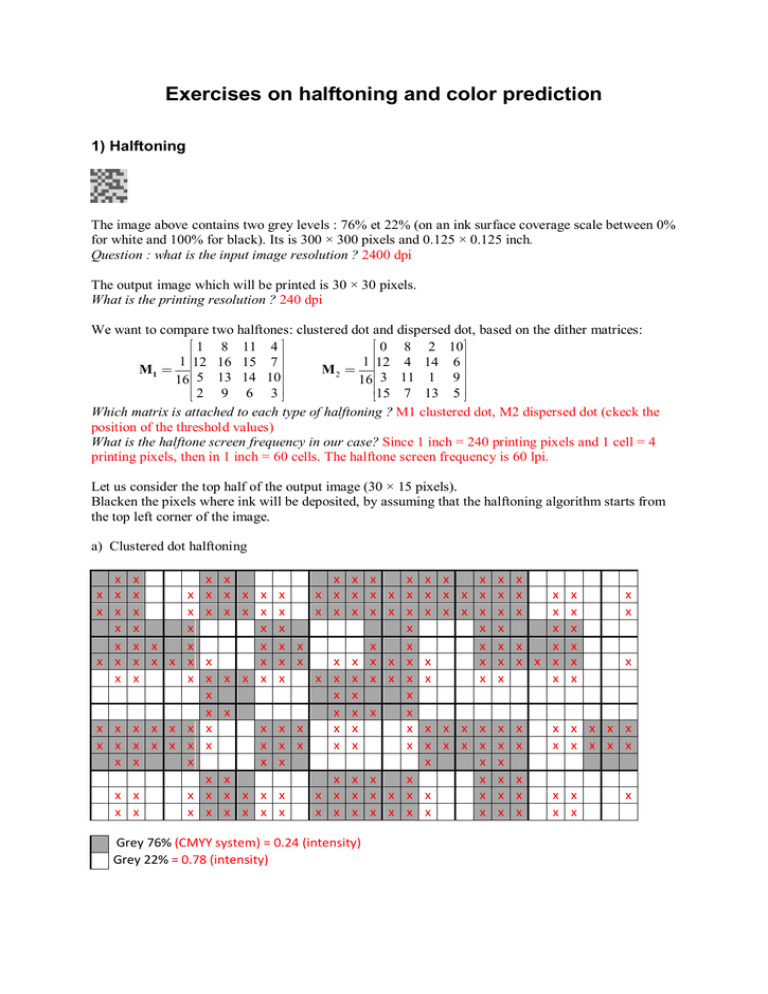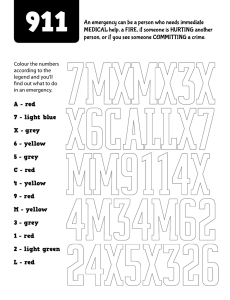Exercises on halftoning and color prediction
advertisement

Exercises on halftoning and color prediction 1) Halftoning The image above contains two grey levels : 76% et 22% (on an ink surface coverage scale between 0% for white and 100% for black). Its is 300 × 300 pixels and 0.125 × 0.125 inch. Question : what is the input image resolution ? 2400 dpi The output image which will be printed is 30 × 30 pixels. What is the printing resolution ? 240 dpi We want to compare two halftones: clustered dot and dispersed dot, based on the dither matrices: 0 8 2 10 1 8 11 4 1 12 16 15 7 1 12 4 14 6 M2 M1 16 5 13 14 10 16 3 11 1 9 15 7 13 5 2 9 6 3 Which matrix is attached to each type of halftoning ? M1 clustered dot, M2 dispersed dot (ckeck the position of the threshold values) What is the halftone screen frequency in our case? Since 1 inch = 240 printing pixels and 1 cell = 4 printing pixels, then in 1 inch = 60 cells. The halftone screen frequency is 60 lpi. Let us consider the top half of the output image (30 × 15 pixels). Blacken the pixels where ink will be deposited, by assuming that the halftoning algorithm starts from the top left corner of the image. a) Clustered dot halftoning x x x x x x x x x x x x x x x x x x x x x x x x x x x x x x x x x x x x x x x x x x x x x x x x x x x x x x x x x x x x x x x x x x x x x x x x x x x x x x x x x x x x x x x x x x x x x x x x x x x x x x x x x x x x x x x x x x x x x x x x x x x x x x x x x x x x x x x x x x x x x x x x x x x x x x x x x x x x x x x x x x x x x x x x x x x x Grey 76% (CMYY system) = 0.24 (intensity) Grey 22% = 0.78 (intensity) x x x x x x x x x x x x x x x x x x x x x x x x x x x x x x x x x x x x x x x x x x x x x x x x x x x x x x x x x x x x x x x x x x x x x x x b) Disperesed dot halftoning x x x x x x x x x x x x x x x x x x x x x x x x x x x x x x x x x x x x x x x x x x x x x x x x x x x x x x x x x x x x x x x x x x x x x x x x x x x x x x x x x x x x x x x x x x x x x x x x x x x x x x x x x x x x x x x x x x x x x x x x x x x x x x x x x x x x x x x x x x x x x x x x x x x x x x x x x x x x x x x x x x x x x x x x x x x x x x x x x x x x x x x x x x x x x x x x x x x x x x x x x x x Would the image be a chessboard, what would probably appear in the halftoned image? Moiré patterns 2) Prediction models An editor is editing a book on the work by a photographer. For the black and white artworks, he decided to use two inks in order to reproduce more reliably the silver print photos: black and grey. Question 1: Give at least two advantages for using two inks. 1) The grey ink may help to reproduce the specific color of silver print photos better than black ink alone. 2) With only black ink, the contrast between paper and ink is maximal, therefore well visible. With grey ink, more paper surface is covered by the inks, and the visibility of the halftones is reduced. Question 2: How many colorants do we have? 22 = 4 colorants (white, grey, black, grey+black). Question 3: The surface coverage of black and grey inks are respectively x et y. What is the surface coverage of the different colorants, assuming classical halftoning? a w = (1-x)(1-y); a g = (1-x) y; a k = x (1-y); a gk = x y The spectral reflectances of the unprinted paper, Rw ( λ ) , the paper coated with black ink Rk ( λ ) and the paper coated with grey ink, Rg ( λ ) are measured. Let us assume that the black ink is fully absorbing (transmittance zero). Question 4: In this special case, how many colorants do we have? 3 colorants, since black and grey+black colorants are confounded. Which are their surface coverages? a w =(1-x)(1-y); a g =(1-x) y; a k = x Question 5: What is the spectral reflectance of the solid black ink patch (coverage 1) if the specular component is not observed ? Zero. And if it is observed ? Zero + reflectance of the surface. Question 6: Express the spectral reflectance Rx ( λ ) of a black ink halftone (no grey ink) whose surface coverage is x, assuming that there is no mechanical dot gain and that the optical dot gain can be modeled by the Yule-Nielsen model with n = 2. NB : RYule − Nielsen = (∑ a R ) i 1/ n n i i Rx ( λ )= (1 − x ) Rw ( λ ) + x Rk ( λ ) 2 Question 7: What surface coverage of black ink would reproduce the nearest grey as a solid grey ink patch? 2 We search x such that Rx ( λ )= (1 − x ) Rw ( λ ) + x Rk ( λ ) = Rg ( λ ) , therefore: x= Rw ( λ ) − Rg ( λ ) Rw ( λ ) − Rk ( λ ) Assume in first approximation that Rw ( λ ) = 1 and Rg ( λ ) =0.5 for all wavelengths. Since Rk ( λ ) =0 , then x = 0.29 . In the general case, R w and R g depend on wavelength and x has a different value for each wavelength. One must choose a value for x, for example the average value over the spectrum. Question 8: Same questions as 6 and 7 using the Clapper-Yule model. TinTexρ ( ∑ ai ti ) = rs + with rs = 0.04, ri = 0.6, TinTex = 0.384 . 1 − riρ ( ∑ ai ti2 ) 2 RClapper −Yule 6) The transmittance of the white colorant is 1 (no ink, therefore no absorption), and the one of the black colorant is 0 (perfectly absorbing ink); hence, TinTex (1 − x ) 1 2 − ri (1 − x ) ρ (λ ) 2 Rx ( λ ) = rs + with Rw ( λ ) − rs ρ (λ ) = TinTex − ri Rw ( λ ) − rs ) Rg ( λ ) , therefore: 7) We search x such that Rx ( λ = x= 1 − x = 0.17 Rg ( λ ) − rs ρ ( λ ) TinTex + ri ( Rg ( λ ) − rs )



